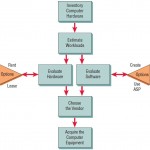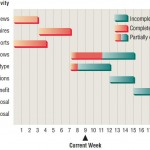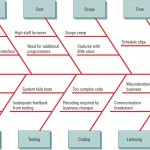Initiating projects, determining project feasibility, scheduling projects, and planning and then managing activities and team members for productivity are all important capabilities for the systems analyst to master. As such, they are considered … [Read more...] about Project Management
Project Management
Project Initiation (Project Management)
Systems projects are initiated by many different sources for many reasons. Some of the projects suggested will survive various stages of evaluation to be worked on by you (or you and your team); others will not and should not get that far. … [Read more...] about Project Initiation (Project Management)
Defining the Problem in Project Initiation (Project Management)
Whether using the classical SDLC or an object-oriented approach, the analyst first defines the problems and objectives of the system. These form the foundation of determining what needs to be accomplished by the system. Methods like Six Sigma (refer … [Read more...] about Defining the Problem in Project Initiation (Project Management)
Selection of Projects
Projects come from many different sources and for many reasons. Not all should be selected for further study. You must be clear in your own mind about the reasons for recommending a systems study on a project that seems to address a problem or could … [Read more...] about Selection of Projects
Feasibility Study – Determining Whether the Project is Feasible
Once the number of projects has been narrowed according to the criteria discussed previously, it is still necessary to determine if the selected projects are feasible. Our definition of feasibility goes much deeper than common usage of the term, … [Read more...] about Feasibility Study – Determining Whether the Project is Feasible
Technical Feasibility – Ascertaining Hardware and Software Needs
Assessing technical feasibility includes evaluating the ability of computer hardware and software to handle workloads adequately. Figure below shows the steps the systems analyst takes in ascertaining hardware and software needs. First, all current … [Read more...] about Technical Feasibility – Ascertaining Hardware and Software Needs
Acquisition of Computer Equipment – Technical Feasibility
The three main options for acquisition of computer hardware are buying, leasing, or renting it. There are advantages and disadvantages that ought to be weighed for each of the decisions, as shown in the table illustration below. Some of the more … [Read more...] about Acquisition of Computer Equipment – Technical Feasibility
Software Evaluation in Technical Feasibility
Analysts and organizations are increasingly faced with a make, buy, or outsource decision when assessing software for information systems projects, particularly when contemplating upgrades to existing or legacy systems.You have seen the decisions … [Read more...] about Software Evaluation in Technical Feasibility
Economic Feasibility – Identifying & Forecasting Costs & Benefits
Costs and benefits of the proposed computer system must always be considered together, because they are interrelated and often interdependent. Although the systems analyst is trying to propose a system that fulfills various information requirements, … [Read more...] about Economic Feasibility – Identifying & Forecasting Costs & Benefits
Comparing Costs and Benefits – Economic Feasibilty
There are many well-known techniques for comparing the costs and benefits of the proposed system. They include break-even analysis, payback, cash-flow analysis, and present value analysis. All these techniques provide straightforward ways of yielding … [Read more...] about Comparing Costs and Benefits – Economic Feasibilty
Activity Planning and Control – Project Management
Systems analysis and design involves many different types of activities that together make up a project. The systems analyst must manage the project carefully if the project is to be successful. Project management involves the general tasks of … [Read more...] about Activity Planning and Control – Project Management
Using PERT Diagrams in Project Planning
PERT is an acronym for Program Evaluation and Review Techniques. A program (a synonym for a project) is represented by a network of nodes and arrows that are then evaluated to determine the critical activities, improve the schedule if necessary, and … [Read more...] about Using PERT Diagrams in Project Planning
Managing the Project
The process of analysis and design can become unwieldy, especially when the system being developed is large. To keep the development activities as manageable as possible, we usually employ some of the techniques of project management to help us get … [Read more...] about Managing the Project
Managing Analysis and Design Activities
Along with managing time and resources, systems analysts must also manage people. Management is accomplished primarily by communicating accurately to team members who have been selected for their competency and compatibility. Goals for project … [Read more...] about Managing Analysis and Design Activities
Creating the Project Charter & Avoiding Project Failures
Creating the Project CharterPart of the planning process is to agree on what will be done and at what time. Analysts who are external consultants, as well as those who are organization members, need to specify what they will eventually deliver … [Read more...] about Creating the Project Charter & Avoiding Project Failures
Organizing the Systems Proposal
While the project charter serves the purpose of identifying objects, determining scope, and assigning responsibilities, the analyst still needs to prepare a systems proposal that includes much of the detail about system needs, options, and … [Read more...] about Organizing the Systems Proposal
Using Figures for Effective Communication in System Proposal
The emphasis so far in this section has been on considering your audience when composing the systems proposal. Tables and graphs as well as words are important in capturing and communicating the basics of the proposed system. Good design should never … [Read more...] about Using Figures for Effective Communication in System Proposal






